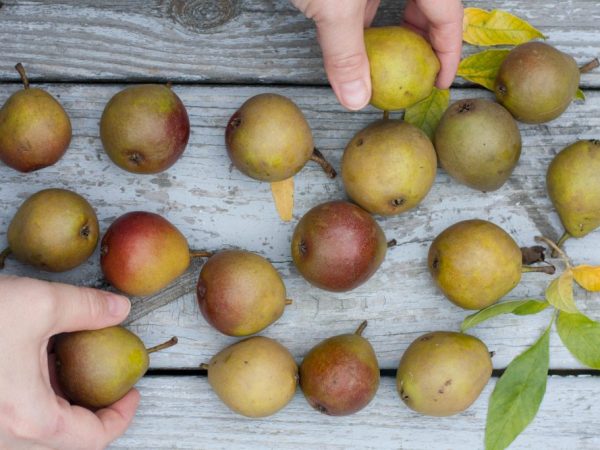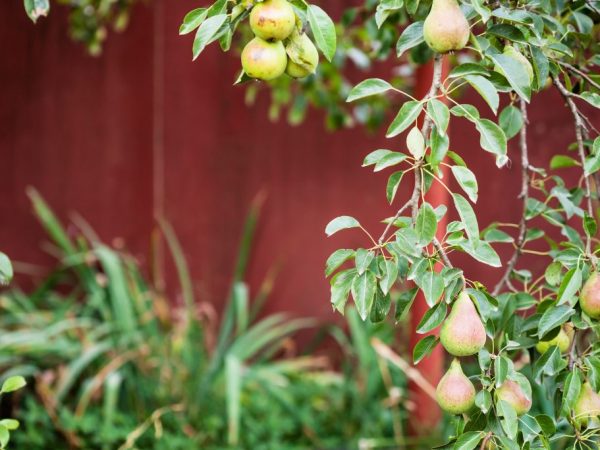Characteristics of Ornamental Curly Pear
Today, orchards are quite diverse. All trees bear bountiful harvests of juicy, aromatic fruits. But few people know about such a beauty as a curly decorative pear. This is a unique culture. She brings a touch of elegance to the exterior. Inedible fruits that are formed on culture only add sophistication. The decorative pear can be used as a hedge, as an original decoration of the personal plot.

Characteristics of Ornamental Curly Pear
Description of decorative pear
The decorative pear came to us from China. She did not receive much distribution in our region, because she needs special care. This tree is medium-sized, with a cone-shaped crown. Beautiful green leaves turn bright red in autumn.
Flowers of decorative pears are rather large and delicate white. The fruits are unattractive, brown in color. You cannot store or preserve such fruits. They are characterized by a slight bitterness. Because of this, they do not have nutritional value.
Decorative curly pear feels great in sunny areas. Able to withstand frost up to -250C. Therefore, this tree is not popular in the northern regions, where winters are much more severe.
The fruit crop can be either an annual or a perennial plant. The decorative beauty demonstrates a high degree of resistance to diseases and pests.
Cultivars
In our region, crops of some varieties are more popular:
- Caliera Chaanticler;
- European version - Beach Hill;
- Willow.
Caliera Chaanticler
This variety of curly beauty is quite widespread in China. It can be found on the banks of water bodies and on the slopes of small hills. In the early stages of development, the tree has a narrow columnar crown. As it grows, the crown becomes wider and more spreading.
The color palette of the leaves is rich. From dark green in summer to yellow, orange, bright red in autumn. Snow-white flowers form bunches. The whole tree is strewn with them. Leaves bloom simultaneously with the abundant flowering of the plant.
A huge number of small fruits are tied on the tree. The diameter of each is less than 1 cm. They can be eaten.
Caliera Chaanticler is not whimsical to the composition of the soil on which it grows. If you choose a site with loose and nutritious soil for planting a decorative beauty, then the tree will sparkle with brighter colors. Easily tolerates prolonged periods of drought. Its main purpose is to create hedges, green arches and other interesting forms that adorn the exterior.
Beach Hill
Beach Hill is found in the European part of the mainland. The crown of the tree is in the shape of a pyramid. Each leaf looks like an egg. Light green elliptical leaves reach a length of 8 cm. In autumn, the tree is painted in bright yellow or orange colors.
White inflorescences appear on the crop in late April - early May. The fruits of this variety of ornamental culture have a round or regular pear-shaped shape. In diameter, each of them can reach 2.5 cm. Such fruits are eaten without being subjected to heat treatment. They have a sour and tart taste.
The root system of the decorative beauty is in the form of a pillar that grows deeper. Plant Beach Hill in a well-lit area, but the plant shows good growth results in partial shade. The soil should be nutritious, calcareous. Susceptible to frost in late spring.
The plant has a fairly strong trunk and a powerful branching structure. Thanks to this, it is able to withstand strong, gusty and prolonged winds. It easily takes root in urban environments. Beach Hill loves moisture, is not afraid of waterlogging. It can grow for almost 150 years.
Willow
The height of the trees of the Ivolistnaya variety does not exceed ten meters. In representatives of this culture, the crown has the shape of a huge egg. Its diameter can reach four meters. Willow is distinguished by a large number of thorns on the branches. Young trunks have a reddish tint; as the tree grows, the bark darkens and cracks.
Narrow leaves grow up to 9 cm long. During blooming, the color of the leaves is silvery-gray. As they grow, their color changes to silvery green. The short stalks of pear leaves give the impression that they are one with the branches.
The curly beauty is undemanding to the composition of the soil. The flowering period of the plant begins in April. May continue until the end of May. Flowers are collected in inflorescences of 8 pieces.
Pear fruits are harvested from September to October. Such fruits are not suitable for heat treatment.
We grow a decorative pear

Growing up won't give you a hassle
It is quite easy to grow a decorative beauty. The annual climbing crop is easily cultivated from seed. To get healthy and strong plants, you need to choose the right terrain and quality seeds.
Choosing seeds
Growing a plant begins with the preparation of seed material. When selecting seeds, follow the advice of professional gardeners:
- To grow a tree, take only a whole, undamaged shift.
- For planting, take seeds in late fall from a cut fresh, fully ripe fruit.
- Rinse the resulting seeds well in hot water.
- Dry them with paper towels.
- Pack them in a bag, seal them tightly.
- Leave in the refrigerator for 3 months.
Site preparation
Choose a site for future beauties in an open, well-lit place. Give preference to small hills and hills. A desirable neighborhood would be a small body of water.
Dig up the ground in the selected area and at the same time apply organic fertilizers. Get rid of the weeds and sprinkle well with hot water.
Seedling
Starting in January, you can start germinating pear seeds. To do this, take them out of the refrigerator, let them warm up at room temperature. Decontaminate with manganese solution.
Then sprout the seeds. Line the bottom of the container with gauze or cloth. Spread the seeds on it. Refill with liquid. The water should saturate the fabric well. Prevent the seeds from floating.
After a few days, the seeds will hatch. Plant them in tofopergous pots. Drizzle and cover with cling film. Leave in a warm place until emergence. After the first shoots appear, remove the film. Observe timely watering. When the weather is warm, take the trees out to the prepared areas.
Disembarkation
Planting a decorative curly pear according to the following instructions:
- Dig a hole.
- Pour superphosphate, humus and lime into it. Observe the ratio 3: 1: 5.
- Set up a seedling pot.
- Sprinkle with soil, compact.
- Be sure to water the plant.Use warm and settled water.
Plant each sprout in a separate hole. According to this scheme, trees and cuttings are planted. If there is not enough space on the site, you can plant a decorative pear on any tree.
Caring for a decorative pear
Highlights in the further care of a decorative beauty:
- moderate watering;
- sufficient illumination;
- timely feeding;
- prevention of diseases and pests;
- crown formation.
Properly organized care of seedlings will be the key to beautiful and strong trees in your garden plot.
In our region, decorative beauty is not widespread. This is due to the fact that the cultivation of such a plant requires milder climatic conditions. Subject to certain rules, this culture is able to revive the landscape landscape and create unique beauty in our area.


